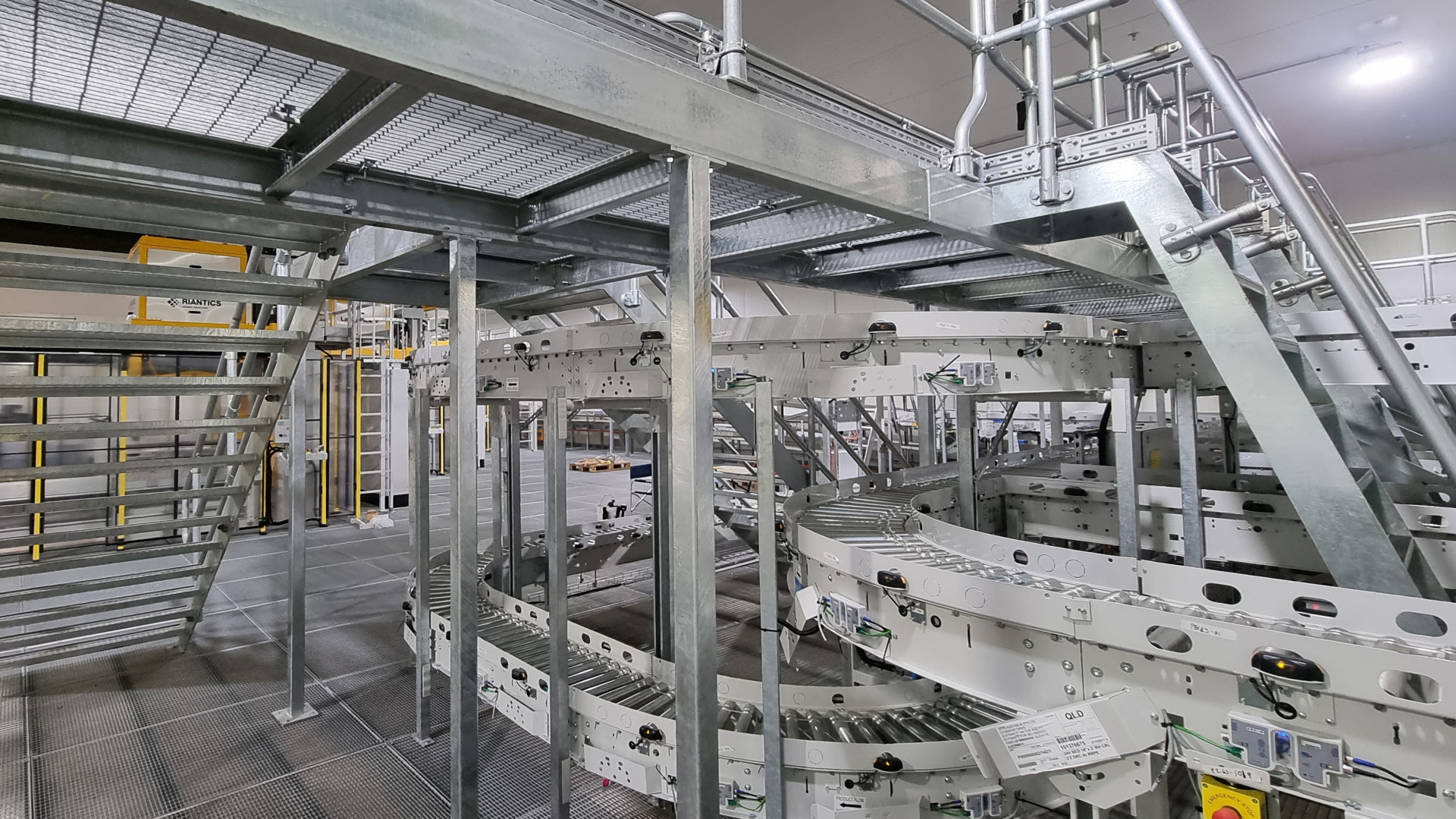Intralogistics covers the movement, storage and flow of materials within warehouses and distribution centres. It’s become a hot area of focus for businesses across Australia, especially as supply chains grow more complex and customer expectations intensify. The last thing any manager wants is a bottleneck that halts productivity or causes costly delays. That’s why many are turning to mezzanine solutions in intralogistics, along with service platforms, crossovers, walkovers and catwalks, to boost material flow efficiency and free up valuable space.
These elevated structures help operations run like clockwork by making better use of vertical space and creating dedicated pathways for workers and equipment. In modern warehouses where space is both costly and coveted, mezzanines and other elevated solutions make it possible to grow without the hassle of relocating or building entirely new facilities. Multi-level warehouse solutions are no longer just nice to have. They’re essential for any business aiming to keep costs down and efficiency up.
Understanding the role of mezzanines and elevated structures in warehouses
Mezzanines in intralogistics typically refer to intermediate floors or platforms installed between the main warehouse floor and the ceiling. They serve as partial levels that can carry stock, equipment or even staff workstations. Warehouse service platforms are similar, though they often specialise in tasks like maintenance and machine operation. Crossovers and walkovers in warehouses help workers and machinery navigate busy environments by allowing people to pass over conveyor belts and other automated systems without stopping the flow of goods. Industrial catwalks are narrower elevated walkways that provide safe access to equipment, storage areas or maintenance points.
By using these elevated structures, businesses can avail themselves of what may be wasted overhead space into productive areas for storage, picking or assembly tasks. This opens the door to greater accessibility and organisation, letting staff reach stock or equipment quickly. In high-density warehouses that handle large volumes of goods in tight quarters, the benefit is massive: you can double or even triple your usable area without adding new real estate.
How mezzanines and elevated structures improve material flow
Optimised vertical space usage
When you’ve got a tight warehouse footprint, expanding upward with mezzanines or catwalks can be a real game-changer. Instead of hunting for off-site storage or rearranging your entire facility, you simply build a second or third level. This helps maintain a consistent workflow on the main floor and keeps everything close at hand for faster processing.
Reduced congestion
It doesn’t take much to gum up the works on a warehouse floor. A few forklift trucks or high-traffic sorting stations and you can end up with queues of pallets. By elevating certain workflows, you separate them from the ground-level traffic and reduce congestion. Crossovers and walkovers in warehouses provide safe routes for staff, so they don’t slow down machinery or risk collisions.
Improved picking and packing efficiency
In fast-paced distribution centres, placing picking stations on an industrial mezzanine can speed up order fulfilment. Workers can move along the upper level collecting items without weaving around pallets or forklifts. This means fewer obstacles, less confusion, and more consistent output. By dedicating certain zones to specific tasks, you also avoid mixing up stock lines.
Enhanced worker safety
Warehouse service platforms, industrial catwalks, and well-designed crossovers limit risky interactions between people and heavy machinery. Nobody wants a near miss with a forklift, so having walkovers and secure platforms keeps staff out of harm’s way. This not only prevents accidents but also helps with compliance checks and insurance concerns.
Integration with automation
Warehouse automation integration can lift productivity to new heights, but only if you have space for conveyors, AGVs, or AS/RS shuttles. Mezzanines and walkovers accommodate these systems below or alongside them. Goods move around automatically without interfering with staff on elevated platforms. This synergy allows your facility to run at full tilt while ensuring employees stay safe.
Industry-specific applications of mezzanines and elevated structures
E-commerce and retail distribution
E-commerce warehouses run at a frantic pace, filling thousands of orders a day. Multi-level warehouse solutions like mezzanines in intralogistics are perfect for setting up picking stations that speed up order processing. Catwalks connect these stations so staff can shift between aisles or zones without clogging the main floor.
Manufacturing and assembly
Manufacturers often need quick access to spare parts or production materials. Service platforms work well for machine maintenance or as staging areas for parts. Crossovers let workers, tools, and materials move between lines without holding up production. This approach helps keep assembly tasks well organised and consistent.
Automotive and heavy industry
Automotive plants handle hefty components, which require sturdy floors. High-load mezzanines allow safe storage of big parts and provide easy access to assembly lines. Walkovers can traverse large sections of a plant, giving engineers quick shortcuts to different stations and reducing the need for ground-level detours.
Food and pharmaceutical warehousing
These facilities often have strict guidelines for cleanliness and contamination control. Elevated storage keeps sensitive items off the floor and away from potential hazards. Some sites add custom mezzanines for temperature-controlled zones, making it easier to organise goods that need precise conditions.
Key considerations for implementing mezzanines and elevated structures
Structural load capacity
Any elevated platform must comply with local engineering standards. If you’re storing heavy products or running machinery, it’s crucial to confirm that your mezzanine can handle the load.
Regulatory and safety standards
Workplace safety laws in Australia outline specific requirements for guardrails, access points and fire safety. It’s best to consult experts who can ensure your design meets these rules
Customisation for industry needs
A one-size-fits-all structure rarely cuts the mustard. Each warehouse has unique workflows and space constraints. You might need adjustable beams, built-in lighting or even integrated conveyor belts to match your operations.
Scalability
Business growth can happen fast. A modular mezzanine gives you the flexibility to expand or reconfigure your warehouse service platforms as your operations evolve. That’ll save you plenty of headaches down the line.
Real-world case studies
A shining example of mezzanines boosting intralogistics efficiency is an e-commerce fulfilment centre that needed to increase order-picking speeds. By installing multi-level mezzanines and carefully planned walkways, they cut travel distances between aisles and improved fulfilment times. Learn more about how we at Unistor adopted this approach with our project for Mongrel Boots.
Another success story involves a logistics hub that integrated walkovers and service platforms to separate pedestrians from machine traffic. This kept foot traffic flowing above the main floor, which was packed with conveyor belts and driverless vehicles. The end result was a safer, more organised workspace. To see a comparable setup, see Unistor’s Kmart project page.
Choose Unistor for elevated intralogistics
Mezzanines in intralogistics, along with walkovers, catwalks, crossovers and warehouse service platforms, provide a sure-fire way to boost material flow efficiency. By using vertical space, these structures let operations expand without incurring the cost or hassle of moving to a bigger site. They also reduce floor congestion and keep staff safe, particularly in high-density facilities juggling multiple processes.
From e-commerce and manufacturing to automotive and food warehousing, elevated structures help slice through complexity by giving teams direct access to the areas that matter most. The right design delivers better performance, cuts running costs, and leaves you well placed to scale. It’s like adding an extra dimension to your warehouse operations.
If your business is ready to explore mezzanines, walkovers, catwalks, or other multi-level warehouse solutions, contact the team at Unistor. With decades of experience in logistics space optimisation, Unistor can help you plan and implement solutions tailored to your unique needs.



